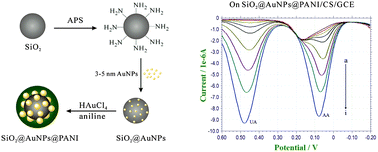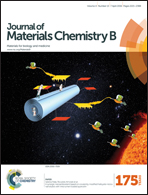Synthesis of a three-layered SiO2@Au nanoparticle@polyaniline nanocomposite and its application in simultaneous electrochemical detection of uric acid and ascorbic acid†
Abstract
Novel nanocomposites fabricated by incorporating different types of nanomaterials, especially inorganic and organic nanomaterials, have attracted much attention, and shown promising prospects in the applications in biological research fields. Herein, we propose a facile method to synthesize a novel three-layered SiO2@Au nanoparticle@polyaniline nanocomposite, which exhibited excellent electrical conductivity and good dispersibility in water. The as-proposed nanocomposite has been adopted to construct the modified electrode SiO2@AuNP@PANI/CS/GCE, which was characterized by electrochemical impedance spectroscopy and cyclic voltammetry, and demonstrated excellent electrochemical behaviors in neutral and even alkaline media, making it suitable for sensing species in biological fluids under physiological conditions. Moreover, the SiO2@AuNP@PANI/CS/GCE exhibited excellent catalytic activity towards the electro-oxidation of uric acid (UA) and ascorbic acid (AA), and a difference of 384 mV between the oxidation potentials for UA and AA was obtained, which is large enough for the selective and simultaneous determination of UA and AA in a binary mixture. Thus, the modified electrode has been successfully adopted for the simultaneous electrochemical detection of UA and AA, and the detection limits of 2 μM and 6 μM were obtained, respectively.


 Please wait while we load your content...
Please wait while we load your content...